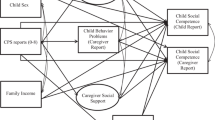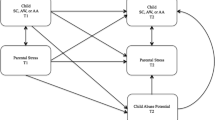Abstract
The stress-social support-psychological well-being model and the social network theory of child development were used to examine the impact of child abuse and maternal perceptions of social support and competence on child perceptions of social support and competence at two points in time. The influence of child social support on child competence was also assessed. The sample consisted of 165 abused children and their mothers and a matched comparison group of 169 nonabused children and their mothers. As a source of stress, abuse had no significant independent effects on children's perceptions of social support and competence at either time period. The strongest predictors of children's views of their competence were perceived support from mothers, peers, and teachers. The findings underscore the importance of social support for the psychological well-being of children.
Similar content being viewed by others
References
Allen, D. M., and Tarnowski, K. J. (1989). Depressive characteristics of physically abused children.J. Abnorm. Child Psychol. 17(1): 1–11.
Arnold, L. E. (ed.) (1990).Childhood Stress, John Wiley, New York.
Baldwin, A. L., Baldwin, C., and Cole, R. E. (1990). Stress-resistant families and stress-resistant children. In Rolf, J., Masten, A. S., Cicchetti, D., Nuechterlein, K. H., and Weintraub, S. (eds.),Risk and Protective Factors in the Development of Psychopathology, Cambridge University Press, Cambridge, pp. 257–280.
Bambring, M., Losel, F., and Skowronek, H. (ed.), (1989).Children at Risk: Assessment, Longitudinal Research, and Intervention, Walter de Gruyter, Hawthorne, NY.
Beardslee, W. (1990). Stress from parental depression: Child risk, self-understanding, and a prevention intervention. In Arnold, L. E. (ed.),Childhood Stress, John Wiley, New York, pp. 351–371.
Beardslee, W. R., Bemporad, J., Keller, M. B., and Klerman, G. L. (1983). Children of parents with major affective disorder: A review.American J. Psychiatry 140(7): 825–832.
Belle, D. (ed.), (1989).Children's Social Networks and Social Supports, John Wiley, New York.
Berndt, T. J. (1989). Obtaining support from friends during childhood and adolescence. In Belle, D. (ed.),Children's Social Networks and Social Supports, John Wiley, New York, pp. 308–331.
Billings, A. G., and Moos, R. H. (1983). Comparisons of children of depressed and nondepressed parents: A social-environmental perspective.J. Abnorm. Child Psychol. 11(4): 463–486.
Cochran, M. M., and Brassard, J. A. (1979). Child development and personal social networks.Child Develop. 50(3): 601–616.
Cohen, S., and Wills, T. A. (1985). Stress, social support, and the buffering hypothesis.Psychological Bull. 98(2): 310–357.
Conger, R. D., Lahey, B. B., and Smith, S. S. (1981, July).An intervention program for child abuse: Modifying maternal depression and behavior, Paper presented at the National Conference for Family Violence Researchers, University of New Hampshire, Durham, NH.
Ensel, W. M., and Lin, N. (1991). The life stress paradigm and psychological distress.J. Health Social Behav. 32(4): 321–341.
Estroff, T. W., Herrera, C., Gaines, R., Shaffer, D., Gould, M., and Green, A. H. (1984). Maternal psychopathology and perception of child behavior in psychiatrically referred and child maltreatment families.J. Am. Acad. Child Psychiatry 23(6): 649–652.
Farber, E. A., and Egeland, B. (1987). Invulnerability among abused and neglected children. In Anthony, E. J., and Cohler, B. J. (eds.),The Invulnerable Child, Guilford Press, New York.
Feldman, R. A., Stiffman, A. R., and Jung, K. G. (eds.) (1987).Children at Risk: In the Web of Parental Illness, Rutgers University Press, New Brunswick, NJ.
Garbarino, J., and Sherman, D. (1980). High-risk neighborhoods and high-risk families: The human ecology of child maltreatment.Child Develop. 51(1): 188–198.
Garmezy, N. (1981). Children under stress: Perspectives on antecedents and correlates of vulnerability and resistance to psychopathology. In Rabin, A. I., Aronoff, J., Barclay, A. M., and Zucker, R. A. (eds.),Further Explorations in Personality, Wiley Interscience, New York, pp. 196–269.
Garmezy, N. (1983). Stressors of childhood. In Garmezy, N., and Rutter, M. (eds.),Stress Coping, and Development in Children, McGraw-Hill, New York, pp. 43–84.
Garmezy, N., and Masten, A. (1990). The adaptation of children to a stressful world: Mastery of fear. In Arnold, L. E. (ed.),Childhood Stress, John Wiley, New York, pp. 459–473.
Garmezy, N., and Tellegen, A. (1984). Studies of stress-resistant children: Methods, variables, and preliminary findings. In Morrison, F. J., Lord, C., and Keating, D. P. (eds.),Applied Developmental Psychology, Academic Press, Orlando, FL, pp. 231–287.
Hamm, S. (1986).Competence and social support as correlates of adult self-worth: Further application of the Adult Self-Perception Profile, Unpublished doctoral dissertation, University of Denver.
Harter, S. (1985a).Manual for the Self-Perception Profile for Children, (Available from Susan Harter, Ph.D., Department of Psychology, University of Denver, Denver, CO 80210).
Harter, S. (1985b).Manual for the Social Support Scale for Children, (Available from Susan Harter, Ph.D., Department of Psychology, University of Denver, Denver, CO 80210).
Harter, S., and Nowakowski, M. (1987).Manual for the Dimensions of Depression Profile for Children and Adolescents, (Available from Susan Harter, Ph.D., Department of Psychology, University of Denver, Denver, CO 80210).
Kauffman, C., Gruenbaum, H., Cohler, B., and Gamer, E. (1979). Superkids: Competent children of psychotic mothers.Am. J. Psychiatry 136(11): 1398–1402.
Kaufman, J. (1991). Depressive disorders in maltreated children.J. Am. Acad. Child Adol. Psychiatry 30: 257–265.
Kimchi, J., and Schaffner, B. (1990). Childhood protection factors and stress risk. In Arnold, L. E. (ed.),Childhood Stress, John Wiley, New York, pp. 475–500.
Kinard, E. M. (1982). Child abuse and depression: Cause or consequence?Child Welfare 61(7): 403–413.
Kinard, E. M. (1994a).Mother and teacher assessments of behavior problems in abused children, Manuscript submitted for publication.
Kinard, E. M. (1994b).Psychosocial resources and academic performance in abused children, Manuscript submitted for publication.
Kinard, E. M. (1994c).Social support, competence, and depression in mothers of abused children, Manuscript submitted for publication.
Koeske, G. F., and Koeske, R. D. (1990). The buffering effect of social support on parental stress.Am. J. Orthopsychiatry 60(3): 440–451.
Koverola, G, Pound, J., Heger, A., and Lytle, C. (1993). Relationship of child sexual abuse to depression.Child Abuse Negl. 17(3): 393–400.
Lewis, M. (1982). The social network systems model: Toward a theory of social development. In Field, T., Huston, A., Quay, H. C., Troll, L., and Finley, G. E. (eds.),Review of Human Development, John Wiley, New York, pp. 180–214.
Lewis, M., and Schaeffer, S. (1981). Peer behavior and mother-infant interaction in maltreated children. In Lewis, M., and Rosenblum, L. A. (eds.),The Uncommon Child, Plenum Press, New York, pp. 193–223.
Lin, N., Ensel, W. M., and Dean, A. (1986). The age structure and the stress process. In Lin, N., Dean, A., and Ensel, W. M. (eds.),Social Support, Life Events, and Depression, Academic Press, Orlando, FL, pp. 213–230.
Lindholm, K. J. (1984, August).Consequences of abuse on children's development and mental health: A conceptual model, Paper presented at the National Conference for Family Violence Researchers, University of New Hampshire, Durham, NH.
Lipsitt, L. P. (1983). Stress in infancy: Toward understanding the origins of coping behavior. In Garmezy, N., and Rutter, M. (eds.),Stress, Coping, and Development in Children, McGraw-Hill, New York, pp. 161–190.
Losel, F., Bliesener, T., and Koferl, P. (1989). On the concept of invulnerability: Evaluation and first results of the Bielefeld Project. In Bambring, M., Losel, F., and Skowronek, H. (eds.),Children at Risk Assessment, Longitudinal Research, and Intervention, Walter de Gruyter, Hawthorne, New York, pp. 186–219.
Luthar, S. S., and Zigler, E. (1991). Vulnerability and competence: A review of research on resilience in childhood.Am. J. Orthopsychiatry 61(1): 6–22.
Maccoby, E. E. (1983). Social-emotional development and response to Stressors. In Garmezy, N., and Rutter, M. (eds.),Stress, Coping and Development in Children, McGraw-Hill, New York, pp. 217–234.
Masten, A. A., Morison, P., Pellegrini, D., and Tellegen, A. (1990). Competence under stress: Risk and protective factors. In Rolf, J., Masten, A. S., Cicchetti, D., Nuechterlein, K. H., and Weintraub, S. (eds.),Risk and Protective Factors in the Development of Psychopathology, Cambridge University Press, Cambridge, pp. 236–256.
Messer, B., and Harter, S. (1986).Manual for the Adult Self-Perception Profile, (Available from Susan Harter, Ph.D., Department of Psychology, University of Denver, Denver, CO 80210).
Orvaschel, H., Weissman, M. M., and Kidd, K. K. (1980). Children and depression: The children of depressed parents; the childhood of depressed patients; depression in children.J. Affect. Dis. 2(1): 1–16.
Palmer, J. D. (1983).The Psychological Assessment of Children (second edition), John Wiley, New York.
Pascoe, J. M., and Earp, J. A. (1984). The effect of mothers' social support and life changes on the stimulation of their children in the home.Am. J. Publ. Health 74(4): 358–360.
Patterson, G. R. (1983). Stress: A change agent for family process. In Garmezy, N., and Rutter, M. (eds.),Stress, Coping, and Development in Children, McGraw-Hill, New York, pp. 235–264.
Radke-Yarrow, M, and Sherman, T. (1990). Hard growing: Children who survive. In Rolf, J., Masten, A. S., Cicchetti, D., Nuechterlein, K. H., and Weintraub, S. (eds.),Risk and Protective Factors in the Development of Psychopathology, Cambridge University Press, Cambridge, pp. 97–119.
Radloff, L. S. (1977). The CES-D scale: A self-report depression scale for research in the general population.Appl. Psychological Measure. 1(3): 385–401.
Rutter, M. (1978). Early sources of security and competence. In Bruner, J. S., and Garton, A. (eds.),Human Growth and Development, Oxford University Press, London, pp. 33–61.
Rutter, M. (1979). Protective factors in children's responses to stress and disadvantage. In Kent, M. W., and Rolf, J. E. (eds.),Primary Prevention of Psychopathology: Social Competence in Children, University Press of New England, Hanover, NH, pp. 49–74.
Rutter, M. (1983). Stress, coping and development: Some issues and some questions. In Garmezy, N., and Rutter, M. (eds.),Stress, Coping, and Development in Children, McGraw-Hill, New York, pp. 1–41.
Rutter, M. (1987). Psychosocial resilience and protective mechanisms.Am. J. Orthopsychiatry 57(3): 316–331.
Salzinger, S., Kaplan, S., and Artemyeff, C. (1983). Mothers' personal social networks and child maltreatment.J. Abnorm. Psychol. 92(1): 68–76.
Sameroff, A. J., and Seifer, R. (1990). Early contributors to developmental risk. In Rolf, J., Masten, A. S., Cicchetti, D., Nuechterlein, K. H., and Weintraub, S. (eds.),Risk and Protective Factors in the Development of Psychopathology, Cambridge University Press, Cambridge, pp. 52–66.
Sandler, I. N., Miller, P., Short, J., and Wolchik, S. A. (1989). Social support as a protective factor for children in stress. In Belle, D. (ed.),Children's Social Networks and Social Supports, John Wiley, New York, pp. 277–307.
Shonkoff, J. P. (1984). Social support and the development of vulnerable children (Editorial).Am. J. Publ. Health 74(4): 310–312.
Wahler, R. G. (1980). The insular mother: Her problems in parent-child treatment.J. Appl. Behav. Anal. 13(2): 207–219.
Walker, E., Downey, G., and Bergman, A. (1989). The effects of parental psychopathology and maltreatment on child behavior: A test of the diathesis-stress model.Child Devel. 60(1): 15–24.
Weintraub, S., Neale, J. M., and Liebert, D. E. (1975). Teacher ratings of children vulnerable to psychopathology.Am. J. Orthopsychiatry 45(5): 838–845.
Werner, E. E. (1989). Vulnerability and resiliency: A longitudinal perspective. In Bambring, M., Losel, F., and Skowronek, H. (eds.),Children at Risk: Assessment, Longitudinal Research, and Intervention, Walter de Gruyter, Hawthorne, New York, pp. 157–172.
Werner, E. E., and Smith, R. S. (1982).Vulnerable but Invincible: A Study of Resilient Children, McGraw-Hill, New York.
Zahn-Waxler, C., Cummings, E. M., McKnew, D. H., and Radke-Yarrow, M. (1984). Altruism, aggression, and social interactions in young children with a manic-depressive parent.Child Devel. 55(1): 112–122.
Zajicek, E., and De Salis, W. (1980). The Family Research Unit study of child development: Description of study and some early results. IV. Depression in mothers of young children. In Kempe, C. H., Franklin, A. W., and Cooper, C. (eds.),The Abused Child in the Family and in the Community, Pergamon Press, Oxford, pp. 833–835.
Author information
Authors and Affiliations
Rights and permissions
About this article
Cite this article
Kinard, E.M. Perceived social support and competence in abused children: A longitudinal perspective. J Fam Viol 10, 73–98 (1995). https://doi.org/10.1007/BF02110538
Issue Date:
DOI: https://doi.org/10.1007/BF02110538




